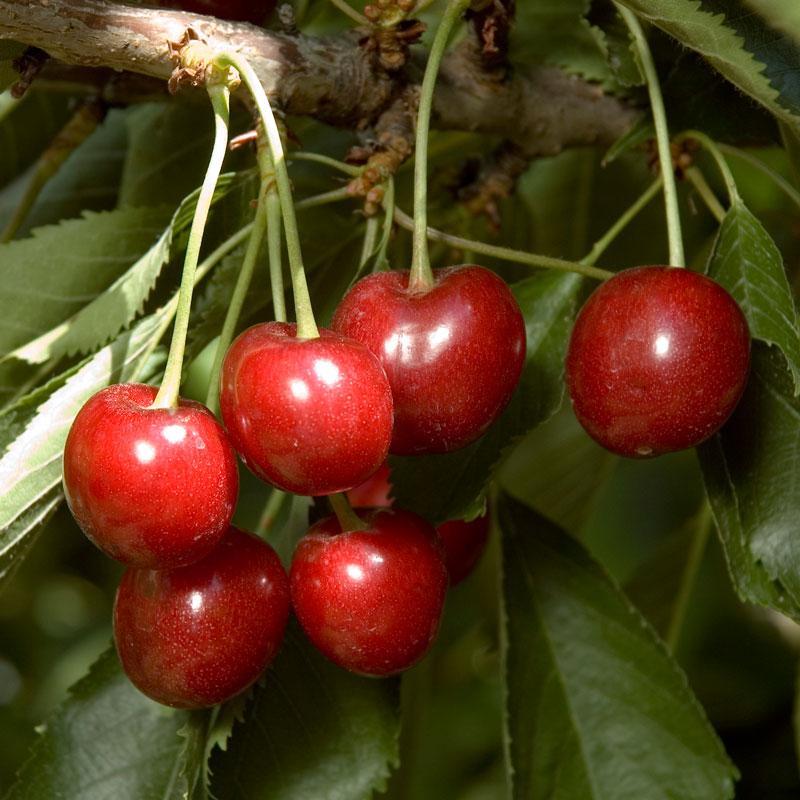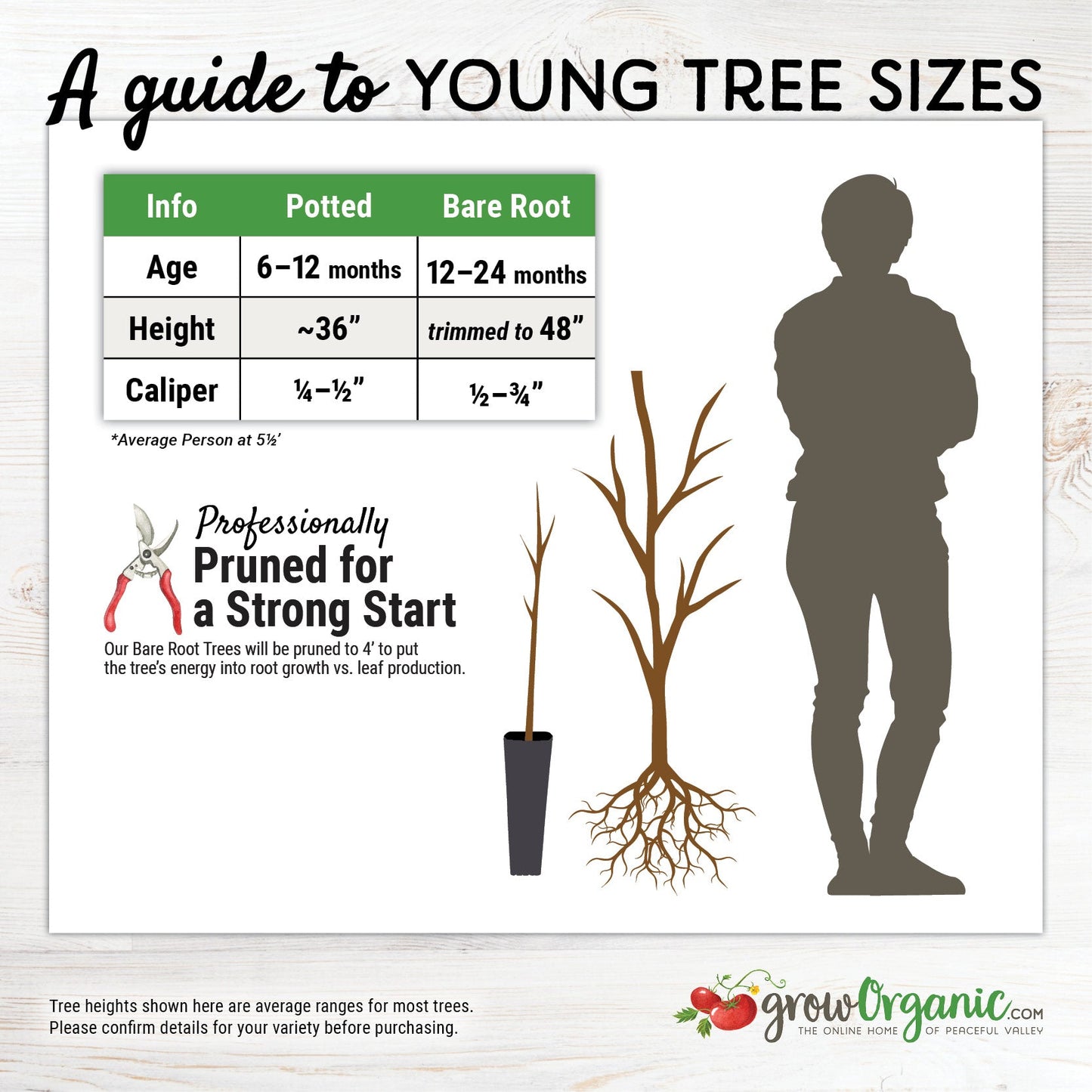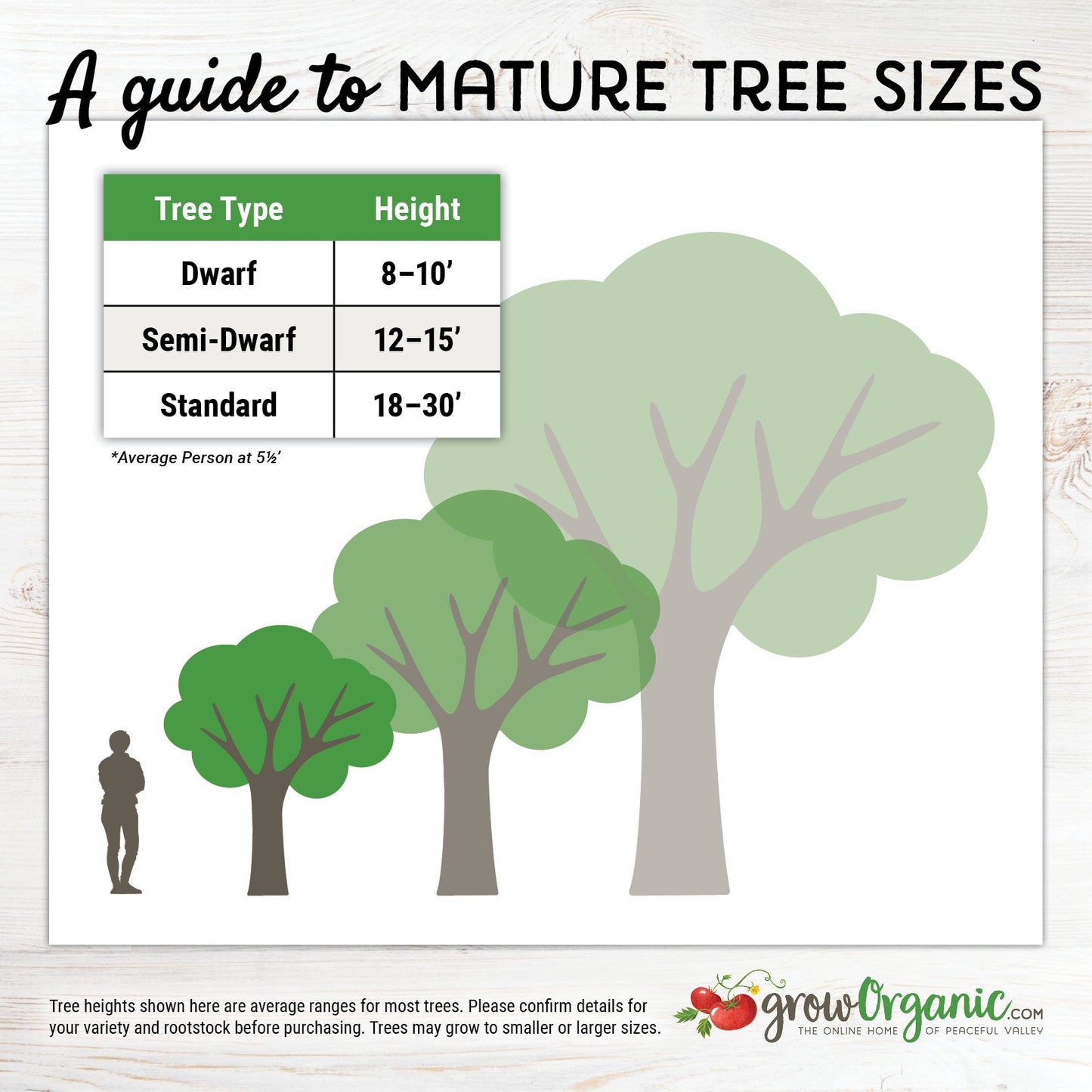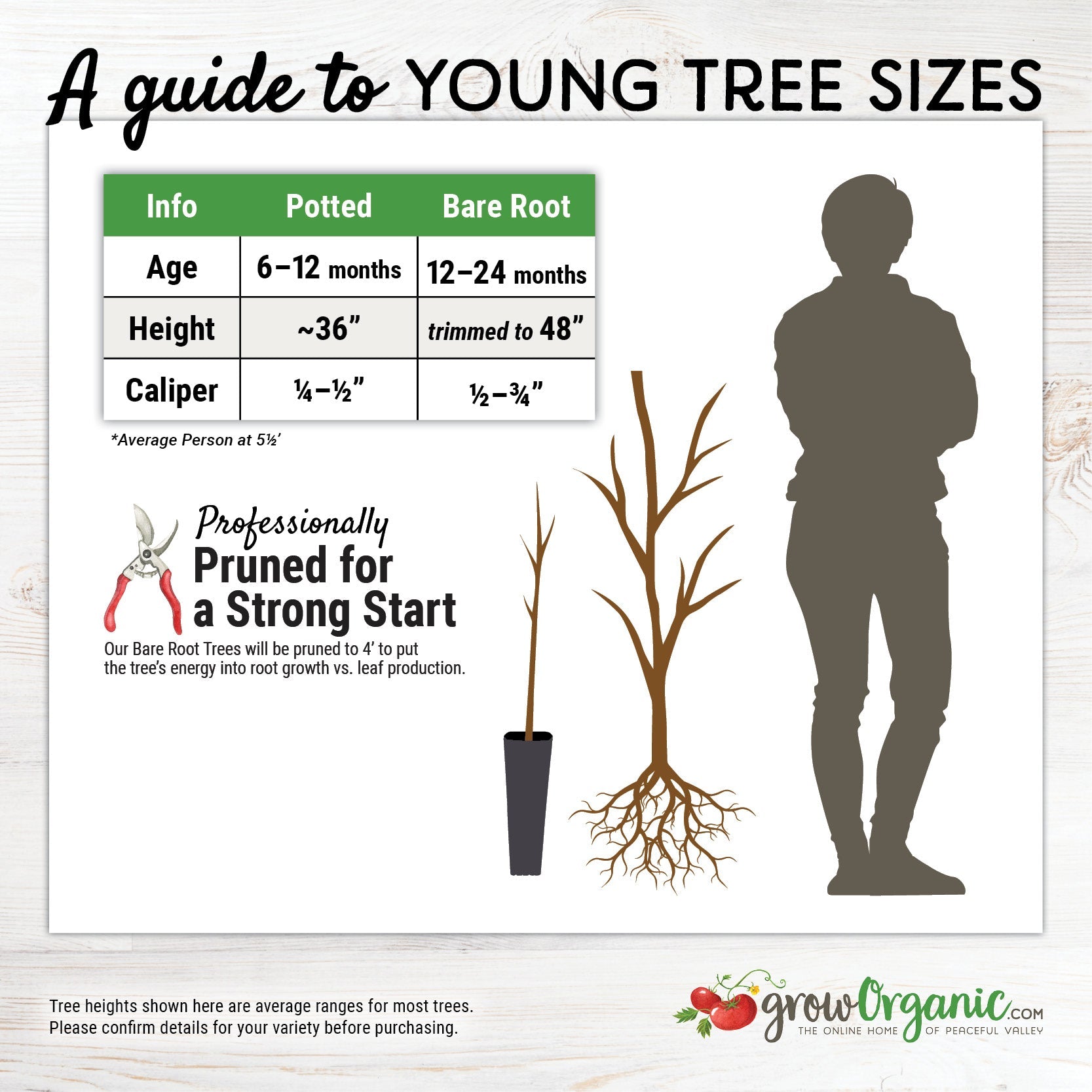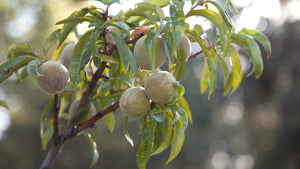Item Number: FT082
Minnie Royal Cherry Tree
Minnie Royal Cherry Tree
Perfect Cherry for Warm Regions
Semi-dwarf on Maxma rootstock.
- Zones: 8-10
- Chill hours: 200-300
- Bloom Time: Early (Based on typical Central Valley California weather)
- Harvest: May 10 - May 20
- Looks: Bright red.
- Personality: Good flavor and firm, crisp flesh.
- Facts of note: Low chill hours required. Early season cherry that holds firmness and flavor on the tree for at least ten days past maturity. One of the first true low-chill cherries. Perfect to be paired with Royal Lee. Zaiger patent.
- Pollination: Pollinated by Royal Lee.
Minnie Royal Cherry Tree: A Delightful Addition to Your Orchard
The Minnie Royal Cherry tree is a semi-dwarf cherry tree variety known for its exceptional fruit production and ornamental beauty. With its vibrant appearance, delectable fruit, and unique attributes, this tree has earned its place as a favorite among home gardeners and orchard enthusiasts.
Appearance of the Minnie Royal Cherry Tree
The Minnie Royal Cherry tree is renowned for its aesthetic appeal. It features a graceful and well-rounded canopy with glossy, dark green leaves that make it an attractive addition to any landscape. During the spring months, the tree produces an abundance of fragrant, pink and white blossoms, adding a touch of elegance to your garden. These blossoms not only create a visually pleasing display but also serve as a source of nectar for pollinators like bees and butterflies, promoting biodiversity in your garden.
As the tree matures, it reaches a height of around 8 to 12 feet, making it an ideal choice for smaller gardens or orchards where space is limited. The semi-dwarf nature of the Minnie Royal Cherry tree allows for easy maintenance and harvesting, as the fruit-bearing branches are within easy reach.
The Fruit of Minnie Royal Cherry Tree
One of the primary reasons gardeners and fruit enthusiasts covet the Minnie Royal Cherry tree is its delicious and abundant fruit. The cherries produced by this tree are medium-sized, with a deep red to mahogany skin color that adds to their visual appeal. The flesh of the fruit is firm, juicy, and exceptionally sweet, making it a delightful treat for both fresh consumption and various culinary applications.
Minnie Royal cherries typically ripen in late spring to early summer, providing a bountiful harvest for your enjoyment. The cherries are typically enjoyed fresh, but they can also be used in pies, jams, jellies, and other desserts. Their sweet and tangy flavor profile adds a burst of flavor to any dish, making them a popular choice among chefs and home cooks alike.
Special Characteristics of the Minnie Royal Cherry Tree
What sets the Minnie Royal Cherry tree apart from other cherry tree varieties are its unique characteristics:
Self-Fertility: Unlike many cherry tree varieties, Minnie Royal is self-fertile, which means it doesn't require another cherry tree for cross-pollination. This feature makes it an excellent choice for those with limited space in their gardens.
Pollination Partner: Although self-fertile, planting a companion tree like the Royal Lee Cherry tree can increase fruit production, as they complement each other's pollination needs. This combination ensures a more robust harvest.
Disease Resistance: Minnie Royal Cherry trees exhibit good resistance to common cherry tree diseases, such as brown rot and powdery mildew. This resilience makes them easier to care for and maintain.
Adaptability: These trees thrive in a wide range of climates, from mild coastal regions to colder inland areas. Their adaptability makes them suitable for various geographic locations.
The Minnie Royal Cherry tree is a remarkable addition to any garden or orchard, offering a blend of beauty, delicious fruit, and unique features. Its ornamental value, self-fertility, and sweet, juicy cherries make it a popular choice for both experienced and novice fruit growers. With proper care and maintenance, this semi-dwarf cherry tree can provide years of enjoyment and fruitful harvests, making it a worthwhile investment for any fruit lover.
Visit our Fruit Tree Central for a listing of all our fruit tree videos and articles.
Visit Tree Characteristics for a listing of all our fruit & nut tree growing characteristics.


Check Your Zone Compatibility:
Compatible with your zone.
Growing Zone for
,

Our Guarantee To You
Since 1976, we've served our customers at every stage of growing. Please contact us at any time. We are happy to support and assist you.
Description
Description
Semi-dwarf on Maxma rootstock.
- Zones: 8-10
- Chill hours: 200-300
- Bloom Time: Early (Based on typical Central Valley California weather)
- Harvest: May 10 - May 20
- Looks: Bright red.
- Personality: Good flavor and firm, crisp flesh.
- Facts of note: Low chill hours required. Early season cherry that holds firmness and flavor on the tree for at least ten days past maturity. One of the first true low-chill cherries. Perfect to be paired with Royal Lee. Zaiger patent.
- Pollination: Pollinated by Royal Lee.
Minnie Royal Cherry Tree: A Delightful Addition to Your Orchard
The Minnie Royal Cherry tree is a semi-dwarf cherry tree variety known for its exceptional fruit production and ornamental beauty. With its vibrant appearance, delectable fruit, and unique attributes, this tree has earned its place as a favorite among home gardeners and orchard enthusiasts.
Appearance of the Minnie Royal Cherry Tree
The Minnie Royal Cherry tree is renowned for its aesthetic appeal. It features a graceful and well-rounded canopy with glossy, dark green leaves that make it an attractive addition to any landscape. During the spring months, the tree produces an abundance of fragrant, pink and white blossoms, adding a touch of elegance to your garden. These blossoms not only create a visually pleasing display but also serve as a source of nectar for pollinators like bees and butterflies, promoting biodiversity in your garden.
As the tree matures, it reaches a height of around 8 to 12 feet, making it an ideal choice for smaller gardens or orchards where space is limited. The semi-dwarf nature of the Minnie Royal Cherry tree allows for easy maintenance and harvesting, as the fruit-bearing branches are within easy reach.
The Fruit of Minnie Royal Cherry Tree
One of the primary reasons gardeners and fruit enthusiasts covet the Minnie Royal Cherry tree is its delicious and abundant fruit. The cherries produced by this tree are medium-sized, with a deep red to mahogany skin color that adds to their visual appeal. The flesh of the fruit is firm, juicy, and exceptionally sweet, making it a delightful treat for both fresh consumption and various culinary applications.
Minnie Royal cherries typically ripen in late spring to early summer, providing a bountiful harvest for your enjoyment. The cherries are typically enjoyed fresh, but they can also be used in pies, jams, jellies, and other desserts. Their sweet and tangy flavor profile adds a burst of flavor to any dish, making them a popular choice among chefs and home cooks alike.
Special Characteristics of the Minnie Royal Cherry Tree
What sets the Minnie Royal Cherry tree apart from other cherry tree varieties are its unique characteristics:
Self-Fertility: Unlike many cherry tree varieties, Minnie Royal is self-fertile, which means it doesn't require another cherry tree for cross-pollination. This feature makes it an excellent choice for those with limited space in their gardens.
Pollination Partner: Although self-fertile, planting a companion tree like the Royal Lee Cherry tree can increase fruit production, as they complement each other's pollination needs. This combination ensures a more robust harvest.
Disease Resistance: Minnie Royal Cherry trees exhibit good resistance to common cherry tree diseases, such as brown rot and powdery mildew. This resilience makes them easier to care for and maintain.
Adaptability: These trees thrive in a wide range of climates, from mild coastal regions to colder inland areas. Their adaptability makes them suitable for various geographic locations.
The Minnie Royal Cherry tree is a remarkable addition to any garden or orchard, offering a blend of beauty, delicious fruit, and unique features. Its ornamental value, self-fertility, and sweet, juicy cherries make it a popular choice for both experienced and novice fruit growers. With proper care and maintenance, this semi-dwarf cherry tree can provide years of enjoyment and fruitful harvests, making it a worthwhile investment for any fruit lover.
Visit our Fruit Tree Central for a listing of all our fruit tree videos and articles.
Visit Tree Characteristics for a listing of all our fruit & nut tree growing characteristics.
Cherries are a practical fruit for home orchards where climate and soil conditions are suitable. Once established, they require little maintenance and are reliable producers. They are best adapted to areas where summers are moderately cool. The trees dislike high humidity. They are usually the last fruit to bloom and first to ripen. Most varieties require a pollenizer. Sweet cherries can reach 25-30 feet tall in deep soils. Sensitive to wet, tight soils. Susceptible to birds, brown rot, and bacterial canker. The trees are 1-2 years old and you can expect to harvest 4th or 5th year. On Maxma rootstock for sweet cherries; trees dwarfed to about 2/3 of standard. Less dwarfing expected in fertile loamy soils. Induces early heavy bearing; crop management may be needed for productive varieties in early years. Good tolerance to wet soils, also performs well in calcareous soils. Resistant to bacterial canker and nematodes. Well anchored, very little suckering.Trees begin bearing at young age. Unpruned, trees on Maxma reach 2/3 the size of standard (about 28'-32'). By pruning, you can keep your tree to any size.
Please Note: Although most of our bare-root trees arrive to our warehouse in mid-December, there are a few varieties that will not arrive until mid-January. If you order any of those varieties along with varieties that arrive in mid-December, your order will be delayed for shipment until mid-January. If you'd like us to split your shipments, please contact us at (888) 784-1722 or orderdesk@groworganic.com. Additional shipping charges will apply.
Shipping Information
Shipping Information
Cannot ship to the following states: HI, AK, PR, GU, VI
Cannot ship via USPS.
Cannot ship via SmartPost.
Shipping Weight: 5.0 lb
Dimensions: 55.5"L x 7.3"W x 2.75"H
Features
Features
- Patented Variety
- Suited to Warmer Climates
Characteristics
Characteristics
Planting & Care
Planting & Care
Useful Information
Useful Information
Guarantee
Guarantee
Limited Dormant Tree & Plant Guarantee
* Claim deadline is June 15th
We guarantee that your dormant tree or plant will arrive in good, viable condition. If your tree arrives in substandard condition, notify us within 3 days of delivery. Please email pictures of the box, inside packaging, the tree and its roots to helpdesk@groworganic.com. We will investigate your claim and process a request to exchange or refund the damaged product.
If your dormant tree or plant has not grown new leaves by June 15th, you may be eligible for our Limited Dormant Tree & Plant Guarantee. This guarantee provides for a store credit for the purchase price of the tree, excluding shipping. Please see the Instructions below.
Important Dates:
- April 1st Dormant trees/plants must be planted in the ground
- May 15th Perform scratch test, if no new leaves have grown
- June 15th Deadline to apply for a dormant tree/plant credit
All required documentation must be received by June 15th for your claim to be considered. Claims or documentation received after June 15th will be denied, without exception. Instructions listed below
Terms and Conditions
We cannot guarantee that your tree or plant will remain alive and healthy after it is received, or bear fruit as there are too many variables in your environment that are beyond our control (i.e. soil preparation, weed and pest control, proper irrigation, chill hours, compatible hardiness for your growing zone, proper choice of pollinator, extreme weather, rodent damage, disease, etc.).
We cannot guarantee that we will be able to provide a replacement tree/plant of the same species either that same growing season or in future years. Customers are responsible for all shipping fees associated with replacement trees and plants.
If we determine that the tree you purchased directly from us is not viable, we will issue you a store credit (not a refund) for the purchase price of the affected dormant tree or plant. Shipping is not included in the dormant tree/plant guarantee. Store credits can be used to purchase any product we sell and are valid for use only until July 1st of the following year.
Historically, 98% of our dormant trees and plants grow and thrive when they have been cared for and planted using our growing guides. Dormant trees and plants must be planted in the ground by April 1st in order to be eligible for credit. If the ground in your area is still frozen solid, you may temporarily plant your tree or plant in a pot.
Potted, non-dormant trees or plants are excluded from this guarantee as they are not dormant at the time of shipment. Evergreen trees such as citrus, avocado and olive trees are not available for credit under the Dormant Tree and Plant Guarantee.
Instructions
We guarantee that your dormant fruit tree or plant will leaf out, if you care for it according to our growing guides. In the unlikely event that your dormant tree or plant does not have leaves by May 15th, follow these simple steps to apply for a store credit:
Before you call or email, please perform a “scratch test” to determine if the tree or plant is still alive. This video shows how to check for live tissue under the bark. Scratch tests need to be done a few inches above and below the graft.
Green Cambium Layer / Living Trees
If the cambium layer under the bark is green, give your tree a little more time. It is still alive, but hasn’t come out of dormancy yet. Check to make sure that it is getting the right amount of deep root water, enough sunlight and that the weather is warm enough for that type of tree/plant to come out of dormancy. Every tree has its own personality and will come out of dormancy at different times. Be sure to submit the required documentation listed below by June 15th, if it doesn’t grow leaves.
Brown Cambium Layer / Dead Trees
If the scratch test shows a brown cambium layer or if your dormant tree/plant doesn’t have leaves by June 1st, please email us at helpdesk@groworganic.com. All required documentation listed below must be received by June 15th for your claim to be considered. To be considered for the guarantee claim, all required documentation must be received by June 15th. Incomplete submissions will be denied.
Required Documentation
- Order number
- Name of dormant tree/plant and the quantity affected
- Photos of each tree or plant showing:
- The roots (tree or plant must be pulled out of the ground)
- The scratch test areas
- The entire tree/plant
We reserve the right to not issue credit for items that have already been replaced. We also reserve the right to require photographic evidence that the tree/plant was not killed by root rot, rodent or mechanical damage.
Share
